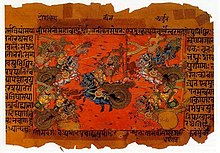
Back Mahabharata Afrikaans Mahabharata ALS Mahābhārata AN महाभारत ANP مهابهاراتا Arabic ماهابهاراتا ARZ মহাভাৰত Assamese Mahabharata AST महाभारत AWA Mahabharata Azerbaijani
| Mahabharata | |
|---|---|
 Manuscript illustration of the Battle of Kurukshetra | |
| Information | |
| Religion | Hinduism |
| Author | Vyasa |
| Language | Sanskrit |
| Period | Principally compiled in 3rd century BCE–4th century CE |
| Chapters | 18 Parvas |
| Verses | 200,000 |
| Full text | |
| Part of a series on |
| Hindu scriptures and texts |
|---|
 |
| Related Hindu texts |
The Mahābhārata (/məˌhɑːˈbɑːrətə, ˌmɑːhə-/ mə-HAH-BAR-ə-tə, MAH-hə-;[1][2][3][4] Sanskrit: महाभारतम्, IAST: Mahābhāratam, pronounced [mɐɦaːˈbʱaːrɐt̪ɐm]) is one of the two major Smriti texts and Sanskrit epics of ancient India revered in Hinduism, the other being the Rāmāyaṇa.[5] It narrates the events and aftermath of the Kurukshetra War, a war of succession between two groups of princely cousins, the Kauravas and the Pāṇḍavas.
It also contains philosophical and devotional material, such as a discussion of the four "goals of life" or puruṣārtha (12.161). Among the principal works and stories in the Mahābhārata are the Bhagavad Gita, the story of Damayanti, the story of Shakuntala, the story of Pururava and Urvashi, the story of Savitri and Satyavan, the story of Kacha and Devayani, the story of Rishyasringa and an abbreviated version of the Rāmāyaṇa, often considered as works in their own right.

Traditionally, the authorship of the Mahābhārata is attributed to Vyāsa. There have been many attempts to unravel its historical growth and compositional layers. The bulk of the Mahābhārata was probably compiled between the 3rd century BCE and the 3rd century CE, with the oldest preserved parts not much older than around 400 BCE.[6][7] The text probably reached its final form by the early Gupta period (c. 4th century CE).[8][9]
The Mahābhārata is the longest epic poem known and has been described as "the longest poem ever written".[10][11] Its longest version consists of over 100,000 śloka or over 200,000 individual verse lines (each shloka is a couplet), and long prose passages. At about 1.8 million words in total, the Mahābhārata is roughly ten times the length of the Iliad and the Odyssey combined, or about four times the length of the Rāmāyaṇa.[12][13] Within the Indian tradition it is sometimes called the fifth Veda.[14]
The title is translated as "Great Bharat (India)", or "the story of the great descendents of Bharata".[15][16]
- ^ "Mahabharata". The Chambers Dictionary (9th ed.). Chambers. 2003. ISBN 0-550-10105-5.
- ^ "Mahabharata". Collins English Dictionary (13th ed.). HarperCollins. 2018. ISBN 978-0-008-28437-4.
- ^ "Mahabharata". Oxford Dictionaries Online.
- ^ "Mahabharata" Archived 4 March 2016 at the Wayback Machine. Random House Webster's Unabridged Dictionary.
- ^ Datta, Amaresh (1 January 2006). The Encyclopaedia of Indian Literature (Volume Two) (Devraj to Jyoti). Sahitya Akademi. ISBN 978-81-260-1194-0.
- ^ Austin, Christopher R. (2019). Pradyumna: Lover, Magician, and Son of the Avatara. Oxford University Press. p. 21. ISBN 978-0-19-005411-3. Archived from the original on 7 September 2023. Retrieved 11 January 2020.
- ^ Brockington (1998, p. 26)
- ^ Pattanaik, Devdutt (13 December 2018). "How did the 'Ramayana' and 'Mahabharata' come to be (and what has 'dharma' got to do with it)?". Scroll.in. Archived from the original on 14 August 2020. Retrieved 30 May 2020.
- ^ Van Buitenen; The Mahabharata – 1; The Book of the Beginning. Introduction (Authorship and Date)
- ^ James G. Lochtefeld (2002). The Illustrated Encyclopedia of Hinduism: A-M. The Rosen Publishing Group. p. 399. ISBN 978-0-8239-3179-8. Archived from the original on 7 September 2023. Retrieved 15 November 2015.
- ^ T. R. S. Sharma; June Gaur; Sahitya Akademi (New Delhi, Inde). (2000). Ancient Indian Literature: An Anthology. Sahitya Akademi. p. 137. ISBN 978-81-260-0794-3. Archived from the original on 7 September 2023. Retrieved 15 November 2015.
- ^ Spodek, Howard. Richard Mason. The World's History. Pearson Education: 2006, New Jersey. 224, 0-13-177318-6
- ^ Amartya Sen, The Argumentative Indian. Writings on Indian Culture, History and Identity, London: Penguin Books, 2005.
- ^ Fitzgerald, James (1985). "India's Fifth Veda: The Mahabharata's Presentation of Itself". Journal of South Asian Literature. 20 (1): 125–140.
- ^ Stuart, Tristram; Albinia, Alice (16 August 2007). "India's epic struggle". The Guardian. Archived from the original on 6 August 2023. Retrieved 6 August 2023.
- ^ "Mahabharata". 16 May 2021. Archived from the original on 6 August 2023. Retrieved 6 August 2023.
© MMXXIII Rich X Search. We shall prevail. All rights reserved. Rich X Search